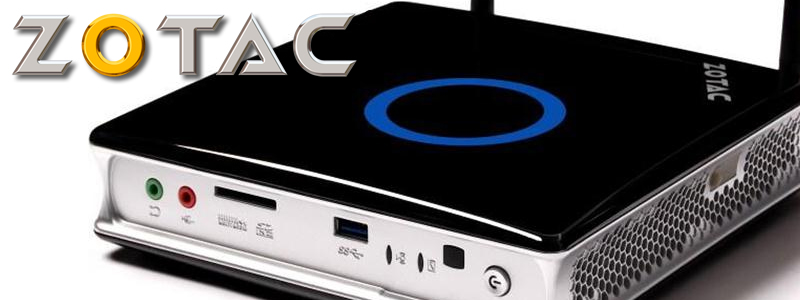Zotac Zbox Plus ID45 Review
Â
Conclusion
The Zotac Zbox range has been around for a fairly long time now. With an incredibly small footprint, they were suited perfectly for people who didn’t necessarily need performance out of their systems, and instead just needed a low cost, static system to allow them to run day to day tasks such as emails, word, and other general office tasks. The series has come on in leaps and bounds since then. We now have systems such as the IQ01 Plus which encorporates a Haswell i7 to give a well performing mini-PC with high capabilities. The Zbox ID45 is the first Zbox released with a dedicated graphics chip able to compete with low end desktop components. From the packaging, it’s fair to assume this is aimed more at the HTPC market, with pictures showing uses in the living room, kitchen and bedrooms, all displaying users using the ID45 as an HTPC through TVs. However, from our tests, we don’t think this is the most ideal use. We think due to the graphical capabilities of this it would be more suited for a low end gaming system, and also for certain office uses which may require a more powerful graphics system, such as smaller photoshop tasks or potential rendering situations. Having said this, the ID45 does seem to be marketed towards its ability to support 4K resolutions, in which case the GT640 may be required for use as an HTPC. Having said this, 4K displays are incredibly rare to find in the standard home and so the market for the ID45 to be used at these kind of resolutions is incredibly small.
To start with the overall look and feel of the ID45, the two side panels are made from a rather cheap feeling plastic. Even with minimal effort, both sides do easily flex. From a device this small, perhaps a metal reinforcement isn’t needed, but it still would have been nice to have the unit feel a little more solid in your hands. When taking the side panel off, this flex is particularly evident, and even though it doesn’t feel as if anything will break, it is certainly disconcerting. Having said this, once it’s actually set up and running, it does look really nice. The gloss black side panels work well with the silver construction on the front, back, top, and sides. The various options for mounting this on its side, standing up, or VESA mounted to the back of the monitor do work a treat for a unit of this size. Consumers buying a PC of a small form factor such as this buy it because they need the versatility and options of putting it anywhere, whether attached to the back of a TV or monitor, or attached to a wall next to a wall mounted TV, or just regularly placed on your desk or TV stand. This does make for a great plus point for a system such as this. As a minor niggle in terms of aesthetics, if the unit is on its side, the two thumbscrews do visibly stand out. It would have been nicer from an aesthetic point of view for these to be ordinary screws to keep continuity throughout the system. The fact that they’ve opted to put a cover over the USB3.0 port on the top panel does make you wonder why a similar minimalistic design wasn’t carried out over the whole outer shell.
It is great however that Zotac do allow you to open up the unit in order to swap hard drives, or add an mSATA SSD without voiding the warranty. The implementation of the thumb screws as previously mentioned even seem to encourage this. Once we are inside, the internals do seem well laid out. We have direct access to change the hard drive, or add an mSATA SSD, and with the removal of a single thumbscrew and then the hard drive, the RAM is very easily accessed too. This is most likely down to the standard ID45 version which you will obviously need to open up in order to install a hard drive or RAM, but nevertheless, this customisability is a great thing to see on factory built systems.
Moving onto to the I/O ports, the ID45 is definitely well equiped as an HTPC, with a built in media card reader, dual ethernet ports, built in AC WiFi and four USB3.0 ports in total. However the lack of analogue audio outputs on the back is a real shame. If this is on a TV stand, and you were wanting to use external speakers you would be left wire wires trailing from the front of the system. Similarly, if this was on your desk as an small form factor PC for general day to day use, then again you would be left with unsightly wires coming from the front. If you were planning on getting sound through HDMI for your TV or monitor, then this won’t affect you at all, but the lack of basic features you’d expect to see on an HTPC is quite a large negative point in our eyes.
As far as heat and noise levels go, the ID45 is outstanding. Even with both the CPU and GPU under maximum load, temperatures don’t go above 65 degrees celcius. Now, because of this, you would expect noise levels to be fairly high, but they aren’t…at all. The ID45 remained completely silent through all of our testing which we were amazed by. If you’re running intensive tasks in the office or at home and can’t deal with the noise that most systems generate, then this might be the perfect choice for you.
Now we reach the performance side of things and the good and bad points are incredibly clear from the results we received. The main issue with this system is the performance from the processor. Having a laptop processor in a small form factor PC is a common thing to see these days; they are incredibly efficient and they don’t produce a great deal of heat which makes cooling them so much easier. Â As the temperatures are clearly acceptable, we see no reason why a more powerful mobile i5 or i7 couldn’t have been put in instead of the poor performing i3. Despite having laptop specifications, the ID45 remains a desktop PC, and when its desktop counterparts are able to perform twice as well as the 3227U like they did in our tests, it does beg the question as to whether the tiny form factor, and impressive temperatures and noise were really worth it. To add to this, it’s perplexing that Zotac have put a last generation Ivybridge processor in the ID45. Haswell mobile i3s have been around since the end of summer and it seems mad for Zotac to be implementing last generation hardware on their latest flagship product. The ludicrosity of this is augmented by the fact that Haswell i3s and i7s are used in other iterations of the Zbox. For the ID45 to be considered a viable alternative to desktop components for overall HTPC use, the processor needs to be more powerful. Hopefully this is just a start as a concept with the well performing low end GPU, and we will see more options in the Zbox when it comes to processors.
To finish with a positive, the GPU performance in the ID45 is great. It consistently produced results which were roughly 30% better than any of the integrated integrated solutions that we tested against. The ID45 could easily be used as a low powered compact gaming system, and for its size, there isn’t really anything else around able to come close to it in terms of performance. In certain games, the GT640 can cope with even more demanding games at higher settings, whilst even the 6800K is left far behind at unplayable levels. If you’re looking for a very small PC for low end gaming, even though the ID45 probably wasn’t intended for gaming on this scale, it does still perform remarkably well.
The Zotac ID45 Plus we are told will be priced at £399.99, and £339.99 for the standard version without the hard drive or RAM. The value for money of these really depends on what exactly you’re wanting from this. £400 is a lot of money for an HTPC regardless of its features and its difficult to recommend someone to buy the ID45 for that purpose when there are so many other iterations of the Zbox capable of fulfilling that task but for significantly less money. However, the ID45 becomes good value for money when this is considered more for a low end gaming PC, or an HTPC with the ability to game. The marketing teams at Zotac seem to be pushing this to be an HTPC however, with pictures of the unit being used to display media to TVs, along with ‘4K’ support being bragged about on the packaging, and a removable sticker on the unit itself. We do think Zotac have made the wrong choice about who to aim the ID45, but still, that doesn’t effect the quality of the product when it comes to other uses such as gaming where it excels.
Due to the impressive performance in gaming, we’re awarding the ID45 the OC3D Silver Award. Zotac really shot themself in the foot here by not putting in a better performing processor, and this is reflected completely in the results. We’re hoping Zotac include a more options for processors in future versions of the Zbox, and if they do, we’re confident they’ll be seeing Gold.
Thanks to Zotac for providing the ID45 Plus for review. You can discuss your thoughts in the OC3D Forums.




